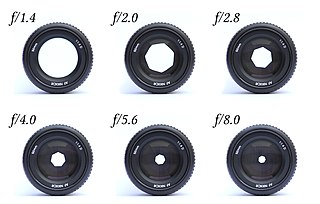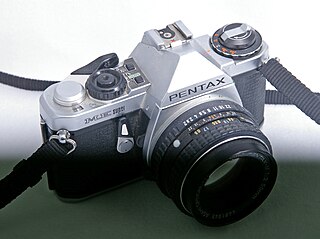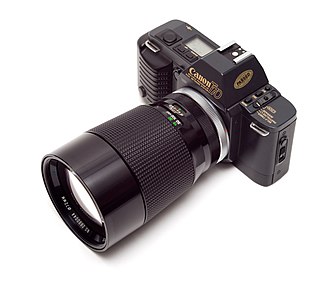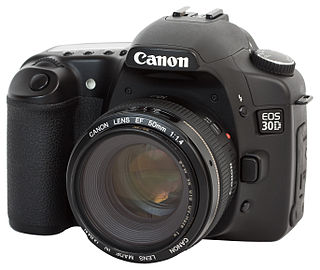
A single-lens reflex camera (SLR) is a camera that typically uses a mirror and prism system that permits the photographer to view through the lens and see exactly what will be captured. With twin lens reflex and rangefinder cameras, the viewed image could be significantly different from the final image. When the shutter button is pressed on most SLRs, the mirror flips out of the light path, allowing light to pass through to the light receptor and the image to be captured.

In optics, an aperture is a hole or an opening through which light travels. More specifically, the aperture and focal length of an optical system determine the cone angle of a bundle of rays that come to a focus in the image plane.

In photography, shutter speed or exposure time is the length of time that the film or digital sensor inside the camera is exposed to light when taking a photograph. The amount of light that reaches the film or image sensor is proportional to the exposure time. 1⁄500 of a second will let half as much light in as 1⁄250.

In photography, exposure is the amount of light per unit area reaching a frame of photographic film or the surface of an electronic image sensor, as determined by shutter speed, lens F-number, and scene luminance. Exposure is measured in lux seconds, and can be computed from exposure value (EV) and scene luminance in a specified region.

In photography, flash synchronization or flash sync is the synchronizing the firing of a photographic flash with the opening of the shutter admitting light to photographic film or electronic image sensor.

In photography, exposure value (EV) is a number that represents a combination of a camera's shutter speed and f-number, such that all combinations that yield the same exposure have the same EV. Exposure value is also used to indicate an interval on the photographic exposure scale, with a difference of 1 EV corresponding to a standard power-of-2 exposure step, commonly referred to as a stop.
In photography, bracketing is the general technique of taking several shots of the same subject using different camera settings. Bracketing is useful and often recommended in situations that make it difficult to obtain a satisfactory image with a single shot, especially when a small variation in exposure parameters has a comparatively large effect on the resulting image. Given the time it takes to accomplish multiple shots, it is typically, but not always, used for static subjects. Autobracketing is a feature of many modern cameras. When set, it will automatically take several bracketed shots, rather than the photographer altering the settings by hand between each shot.
The science of photography is the use of chemistry and physics in all aspects of photography. This applies to the camera, its lenses, physical operation of the camera, electronic camera internals, and the process of developing film in order to take and develop pictures properly.

The Canon A-1 is an advanced-level single-lens reflex (SLR) 35 mm film camera for use with interchangeable lenses. It was manufactured by Canon Camera K. K. in Japan from April 1978 to 1985. It employs a horizontal cloth-curtain focal-plane shutter with a speed range of 30 to 1/1000 second plus bulb and flash synchronization speed of 1/60 second. It has dimensions of 92 millimetres (3.6 in) height, 141 millimetres (5.6 in) width, 48 millimetres (1.9 in) depth and 620 grams (22 oz) weight. Unlike most SLRs of the time, it was available in only one color; all black. The introductory US list price for the body plus Canon FD 50 mm f/1.4 SSC lens was $625; the camera body was generally sold with a 30–40% discount.

In photography and optics, a neutral-density filter, or ND filter, is a filter that reduces or modifies the intensity of all wavelengths, or colors, of light equally, giving no changes in hue of color rendition. It can be a colorless (clear) or grey filter, and is denoted by Wratten number 96. The purpose of a standard photographic neutral-density filter is to reduce the amount of light entering the lens. Doing so allows the photographer to select combinations of aperture, exposure time and sensor sensitivity that would otherwise produce overexposed pictures. This is done to achieve effects such as a shallower depth of field or motion blur of a subject in a wider range of situations and atmospheric conditions.

The Canon EF is a manual focus 35mm single-lens reflex camera produced by Canon between 1973 and 1978. It was compatible with Canon's FD-mount lenses. The EF was built as an electro-mechanical version of Canon's top-of-the line wholly mechanical Canon F-1. The shutter is mechanical at all speeds starting at 1/2 second and faster, but from 1 second and beyond the shutter is all electric, allowing for AE shutter speeds as long as 30 seconds. The EF shares the F-1's rugged construction and tough metal body. Unlike the F-1, the EF does not support any motor drive for film transport. Neither does it provide any interchangeable viewfinder.

The Canon T70 was a 35mm FD-mount single-lens reflex camera introduced in April 1984 as the second in Canon's T series. The T70 started with the concepts explored in 1983's T50, took them further, and applied them to a more sophisticated camera. While the Program AE-only T50 was intended as a beginner's camera, the T70 gave the photographer a lot more control over the camera's operation while keeping the T-series philosophy of simplicity in control and operation intact.

The Canon EOS 30D is an 8.2-megapixel semi-professional digital single-lens reflex camera, initially announced on February 21, 2006. It is the successor of the Canon EOS 20D, and is succeeded by the EOS 40D. It can accept EF and EF-S lenses, and like its predecessor, it uses an APS-C sized image sensor, so it does not require the larger imaging circle necessary for 35 mm film and 'full-frame' digital cameras.

Sports photography refers to the genre of photography that covers all types of sports.

A mode dial or camera dial is a dial used on digital cameras to change the camera's mode. Most digital cameras, including dSLR and SLR-like cameras, support modes, selectable either by a rotary dial or from a menu. On point-and-shoot cameras which support modes a range of scene types is offered. On dSLR cameras and SLR-like cameras, mode dials usually offer access to manual settings. The more compact point-and-shoot cameras, and cameras offering a great many modes, do not have mode dials, using menus instead. Some SLR lenses themselves offer control over things such as aperture, reducing the need for mode support in the camera body.

The Konica Hexar is a 35 mm fixed-lens, fixed focal length autofocus camera which was produced through the 1990s. It was introduced to the market in 1993. While styled like a rangefinder camera, and intended for a similar style of photography, in specification it is more like a larger "point and shoot" camera.

Most digital cameras support the ability to choose among a number of configurations, or modes, for use in various situations. Professional DSLR cameras provide several manual modes; consumer point-and-shoot cameras emphasize automatic modes; amateur prosumer cameras often have a wide variety of both manual and automatic modes.

Landscape photography shows the spaces within the world, sometimes vast and unending, but other times microscopic. Landscape photographs typically capture the presence of nature but can also focus on man-made features or disturbances of landscapes. Landscape photography is done for a variety of reasons. Perhaps the most common is to recall a personal observation or experience while in the outdoors, especially when traveling. Others pursue it particularly as an outdoor lifestyle, to be involved with nature and the elements, some as an escape from the artificial world.
Sensitivity priority, often abbreviated Sv on a camera dial, and colloquially called "ISO priority", is a setting on Pentax cameras that allows the user to choose a specific Sensitivity value while the camera selects a shutter speed and aperture to match. The camera will ensure proper exposure. This is different from manual mode, where the user must decide all three values, shutter priority where the user picks a shutter speed with the camera selecting the aperture to match, or program mode where the camera selects all three.

Canon EOS 1100D is a 12.2-megapixel digital single-lens reflex camera announced by Canon on 7 February 2011. It is known as the EOS Kiss X50 in Japan and the EOS Rebel T3 in the Americas. The 1100D is Canon's most basic entry-level DSLR, and introduces movie mode to other entry level DSLRs. It replaced the 1000D and is also the only Canon EOS model currently in production that is not made in Japan but in Taiwan, aside from the EOS Rebel T4i.
















